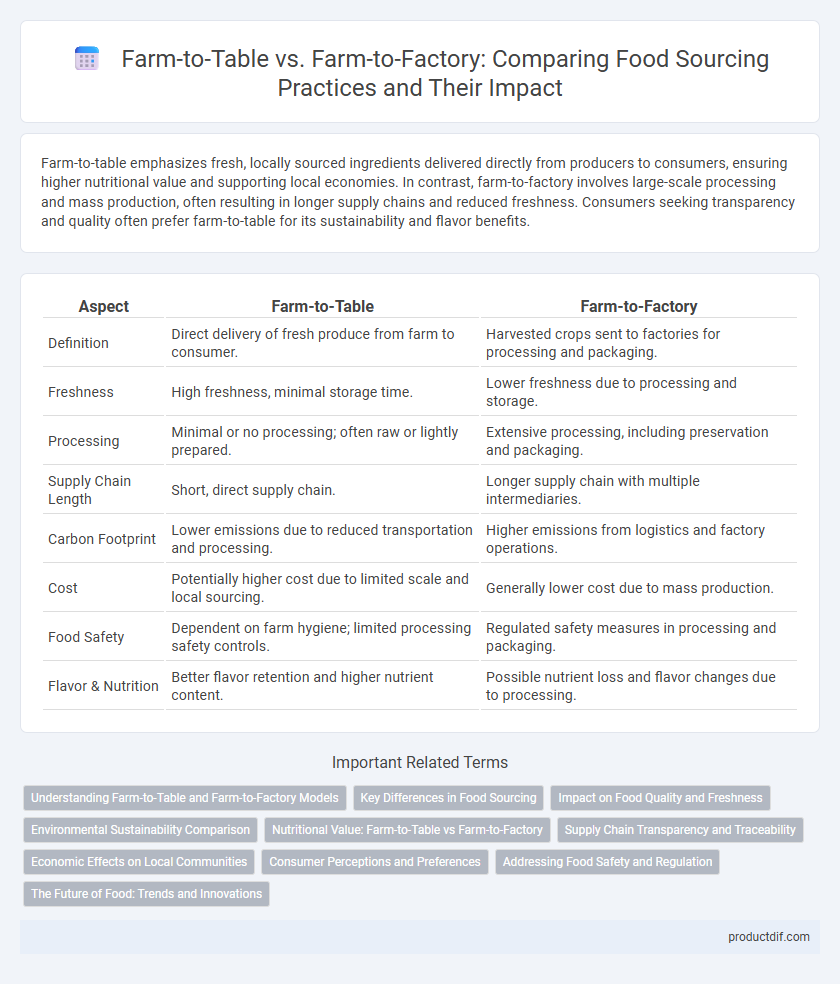Farm-to-table emphasizes fresh, locally sourced ingredients delivered directly from producers to consumers, ensuring higher nutritional value and supporting local economies. In contrast, farm-to-factory involves large-scale processing and mass production, often resulting in longer supply chains and reduced freshness. Consumers seeking transparency and quality often prefer farm-to-table for its sustainability and flavor benefits.
Table of Comparison
| Aspect | Farm-to-Table | Farm-to-Factory |
|---|---|---|
| Definition | Direct delivery of fresh produce from farm to consumer. | Harvested crops sent to factories for processing and packaging. |
| Freshness | High freshness, minimal storage time. | Lower freshness due to processing and storage. |
| Processing | Minimal or no processing; often raw or lightly prepared. | Extensive processing, including preservation and packaging. |
| Supply Chain Length | Short, direct supply chain. | Longer supply chain with multiple intermediaries. |
| Carbon Footprint | Lower emissions due to reduced transportation and processing. | Higher emissions from logistics and factory operations. |
| Cost | Potentially higher cost due to limited scale and local sourcing. | Generally lower cost due to mass production. |
| Food Safety | Dependent on farm hygiene; limited processing safety controls. | Regulated safety measures in processing and packaging. |
| Flavor & Nutrition | Better flavor retention and higher nutrient content. | Possible nutrient loss and flavor changes due to processing. |
Understanding Farm-to-Table and Farm-to-Factory Models
Farm-to-table emphasizes direct sourcing of fresh produce from local farms, ensuring higher food quality, reduced transportation, and support for regional agriculture. Farm-to-factory involves large-scale production where raw agricultural products are processed into packaged food items, prioritizing volume and shelf-life over freshness. Understanding these models highlights the impact on sustainability, food traceability, and consumer health preferences.
Key Differences in Food Sourcing
Farm-to-table emphasizes direct sourcing of fresh, locally grown ingredients, ensuring minimal processing and maximum nutritional value. Farm-to-factory involves large-scale procurement of raw materials for industrial food production, often leading to longer supply chains and added preservatives. The core difference lies in freshness and transparency, with farm-to-table prioritizing sustainability and traceability, whereas farm-to-factory aims for mass production and extended shelf life.
Impact on Food Quality and Freshness
Farm-to-table sourcing ensures higher food quality and freshness by reducing the time between harvest and consumption, preserving natural flavors and nutrients. In contrast, farm-to-factory processes often involve longer transportation and storage times, which can degrade food quality through exposure to varying temperatures and handling. Minimizing the supply chain length is critical for maintaining the integrity of perishable produce and enhancing the overall taste experience.
Environmental Sustainability Comparison
Farm-to-table promotes environmental sustainability by reducing transportation emissions through local sourcing, minimizing the carbon footprint associated with long supply chains. Farm-to-factory often involves large-scale processing and extended distribution networks, leading to higher energy consumption and increased greenhouse gas emissions. Emphasizing direct farm-to-table models supports biodiversity and soil health by encouraging sustainable agricultural practices and decreasing reliance on industrial inputs.
Nutritional Value: Farm-to-Table vs Farm-to-Factory
Farm-to-table foods typically retain higher nutritional value due to minimal processing and shorter time between harvest and consumption, preserving essential vitamins and antioxidants. In contrast, farm-to-factory products often undergo extensive processing, packaging, and extended storage, which can degrade nutrients and introduce additives. Consumers prioritizing nutrient-dense diets benefit more from fresh, locally sourced farm-to-table produce than from factory-processed alternatives.
Supply Chain Transparency and Traceability
Farm-to-table models emphasize direct supply chain transparency by tracing food from local farms to consumers, ensuring authenticity and freshness. In contrast, farm-to-factory processes often involve multiple intermediaries, complicating traceability and increasing the risk of information gaps. Enhanced digital tracking technologies, such as blockchain, are crucial for improving accountability and visibility in both food supply chains.
Economic Effects on Local Communities
Farm-to-table promotes local economic growth by supporting small-scale farmers and increasing demand for fresh, locally sourced products, resulting in higher income retention within communities. Farm-to-factory often centralizes production, leading to job displacement in rural areas while benefiting large-scale industrial operations. Local economies experience greater resilience and diversified revenue streams when farm-to-table models are prioritized over industrialized food processing.
Consumer Perceptions and Preferences
Consumer perceptions of farm-to-table emphasize freshness, sustainability, and direct support for local farmers, creating a preference for transparent sourcing and minimal processing. In contrast, farm-to-factory often raises concerns about quality dilution and environmental impact despite its efficiency and scalability. Surveys indicate a growing demand for farm-to-table products driven by health-conscious and environmentally aware consumers who value traceability and artisanal food production.
Addressing Food Safety and Regulation
Farm-to-table emphasizes direct sourcing from local farms, reducing contamination risks through minimal processing and stringent hygiene standards, while farm-to-factory involves large-scale production with complex supply chains requiring rigorous regulatory compliance and consistent food safety protocols. Food safety regulations such as Hazard Analysis and Critical Control Points (HACCP) and FDA guidelines are critical in both models to prevent contamination, ensure traceability, and maintain public health standards. Enhanced transparency and monitoring technology like blockchain further strengthen food safety management across farm-to-factory systems, bridging gaps more inherent in the traditional farm-to-table approach.
The Future of Food: Trends and Innovations
Farm-to-table emphasizes fresh, locally sourced ingredients, promoting sustainability and reducing food miles, while farm-to-factory focuses on large-scale processing and distribution to meet growing global demand. Advances in precision agriculture, vertical farming, and biotechnologies are driving innovations that enhance food quality, traceability, and environmental impact across both models. Emerging trends include blockchain for supply chain transparency and alternative proteins, shaping the future landscape of food production and consumption.
farm-to-table vs farm-to-factory Infographic

 productdif.com
productdif.com